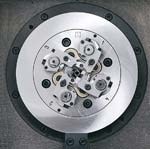A Lathe That Doesn't Turn The Workpiece
Rather than rotating the workpiece, an Escomatic lathe rotates a toolhead around material that is held stationary in a guide bushing. This configuration allows workpiece stock to be fed as bars or coils for long periods of uninterrupted operation.
The essence of turning on a lathe is to rotate the workpiece as a rigidly held cutting tool is brought to bear along the length or across the face of the workpiece. One class of lathes, however, holds the workpiece steady as the toolhead rotates around it. Cams or CNC servo units within the head move two or more cutting tools to perform a variety of lathe-type operations. This configuration allows such a machine to produce “turned” parts that would be difficult, more costly or slower to produce any other way.
The concept of holding the stock steady while rotating a toolhead around it was developed more than 50 years ago by a parts maker in Switzerland. Esco, the Swiss company formed to build machines embodying this concept, continues to design and manufacture these unusual lathes as part of its Escomatic line. Although all of these machines follow the Esco turning concept, the line includes standard and customized versions, several of which incorporate units for machining the front end and/or the back end of the part to produce it complete on one machine. In North America, Tornos Technologies (Brookfield, Connecticut) is now responsible for service, sales and application support of new and existing Escomatic lathes.
One of the most important benefits of rotating the toolhead around the stationary workpiece stock is that it can be fed as bars or coils from 0.02 mm to 12 mm in diameter. Round or profiled material can be used. Large coils of material allow continuous machining for extended periods without downtime. The stock is held in place by feed rollers and a set of guide bushings as material is removed by cutting tools in the rotating wheelhead.
For coiled stock up to 6 mm in diameter, a straightening unit must be used to straighten the incoming material before it is fed into the rollers and guide bushings. A rotating straightener is standard on the Esco machine line. It revolves around the stock, straightening it with a combination of moves as the stock passes through five bushings. The center bushing is adjustable; it cambers the stock as the unit rotates. For material from 6 mm to 9 mm in diameter, a roller straightener is available.
After passing through the straightener, the material is clamped between a set of grooved rollers, which rotate to feed the material into the cutting zone. The grooves can be round for wire or contoured to match profiled stock. By locating the rollers close to the guide bushing, small diameter wire can be machined without bending or whipping.
Depending on the model, the toolhead rotates between 8,000 to 12,000 rpm. The toolholders pivot into the workpiece stock rather than entering directly along the radial axis. The resulting tool stroke follows an arc, helping to compensate for the outward thrust of centrifugal force. The tool stroke is very short, minimizing cycle time. After the machining cycle is complete, a counter collet supports the workpiece for cutoff. Supporting the part produces a flat, clean end with no nib at the center.
Workpieces that lend themselves to production on these machines include automotive parts, connectors, components for watch making, jewelry, parts for lock manufacturing, medical and dental components.
Read Next
The Cut Scene: The Finer Details of Large-Format Machining
Small details and features can have an outsized impact on large parts, such as Barbco’s collapsible utility drill head.
Read More3 Mistakes That Cause CNC Programs to Fail
Despite enhancements to manufacturing technology, there are still issues today that can cause programs to fail. These failures can cause lost time, scrapped parts, damaged machines and even injured operators.
Read More










.png;maxWidth=300;quality=90)












